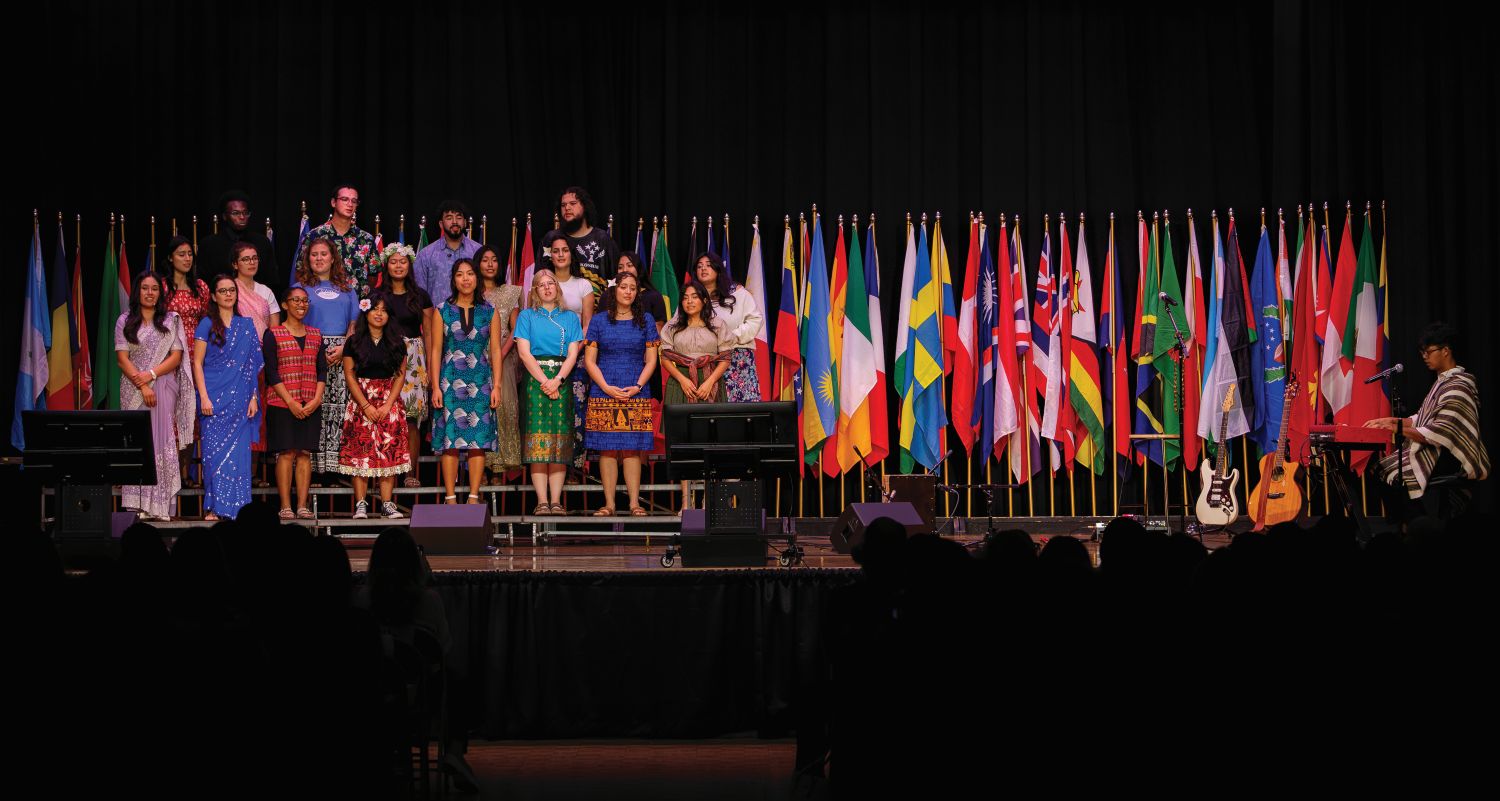By Eliana Morales
Diversity was not something I expected to see when I came to Collegedale. I’m Chinese, raised in Hispanic culture, and for most of my life, I was used to being one of the only people with a multicultural background.

I’m also an only child, so I was stuck hanging out with mostly adults for much of my life. But at Southern, for the first time, I’m surrounded by people from all backgrounds, many of whom are my age, going through similar experiences. Somehow, it’s the most diversity I’ve ever experienced, and I wonder if Collegedale has always looked like this. My research has uncovered more racial diversity and shifts in age, health and religion. It’s subtle in some ways, but if you’re paying attention, you can see how the community evolves.
Over the past decade, Collegedale has seen a shift in its racial and ethnic demographics. According to the ACS Demographic and Housing Estimates survey, the town's population is becoming more diverse. In 2010, the population was 76.7% white, 8.4% Black, 4.3% Asian and 10.6% Hispanic.
By 2023, the percentage of white residents had decreased to 70.8%, while the Black population grew to 11.5%, the Asian population remained the same and the Hispanic population rose to 13.4%.
According to the U.S. Census, Collegedale’s Hispanic and Asian population is nearly twice as high as the state average. While Asians only make up 4.3% of the general population, they represented 16% of Southern’s student body in Fall 2024.
Elias Martinez, a current resident, moved to the Collegedale area in 2017 for work and attended Southern in 2012.
“Since I first got here, it’s way more diverse,” he said. “When I was a freshman going to Walmart, I felt like I was the only Hispanic there. I've noticed a bigger influx of diversity. It wasn't dramatic, but when I was in college, I didn't feel comfortable as much as I do now.”
To residents, Collegedale may seem more diverse than statistics suggest, likely because census data doesn’t consider the students who come to college from out of state. However, these students live here, bringing international representation and engaging with local businesses, organizations and community events, all of which help shape the town's evolving cultural landscape.
According to a previous Accent article, Southern is the only Hispanic-Serving Institution in Tennessee. In Fall 2024, enrollment statistics showed that Hispanic students made up 28.59% of the student body.
Beyond cultural diversity, age is another clear part of how Collegedale’s population is shifting. With college students and young adults living in the area, the city can feel younger than it used to. Back in 2015, 38.3% of residents were between 10 and 34 years old. By 2023, that number had grown to 45.1%.
Raquel Acosta and her family moved to Collegedale about four years ago, wanting to leave behind the fast-paced, traffic-heavy lifestyle of Florida. She shared that her husband felt a spiritual calling to relocate, which ultimately led them to the area. One thing she appreciates about Collegedale is the respectfulness of its young people and their willingness to help older adults.
In 2023, adults between 35 and 64, the age group that makes up the majority of the workforce, were 33.4% of the population. That’s close to what it was back in 2010, after some changes over the years. Seniors over 65 made up 17.3% of the population, a number that’s stayed about the same since 2010. Interestingly, the number of people aged 80 and older is about 10% higher than in Chattanooga and nearly 30% higher than the Tennessee state average.
Laura Howse, Collegedale Commissioner, said, “We had a huge rush of people [move here] because they were trying to get away from the COVID lockdowns. Even in my own neighborhood, we've had younger people who moved in, and now their parents are moving here.” This generational mix, especially the strong presence of older adults, highlights the importance of supporting long-term well-being.
According to the County Health Rankings, “Hamilton County is faring better than the average county in Tennessee for Health Factors, and slightly better than the average county in the nation.” Dr.
Gregory Heath, Professor Emeritus in public health at UTC and former lead scientist at the CDC, emphasizes the importance of designing communities where “the healthy choice is the easy choice.”
He stated, “The sense of place and community plays a big role in a population's health.” In a survey, his team found that “people who live more proximal to a park setting or even some kind of fitness center were more likely to be active. They were also more likely to have better health profiles. They were less likely to smoke, and they were more likely to eat real [instead of processed] food.” For a city like Collegedale, moving toward a healthier community starts with improving the environment. In Hamilton County, 86% of people now live near a park or recreational facility, compared to 78% in 2014. These statistics reflect Dr. Heath’s point and indicate a community that’s becoming healthier by design.
The health of a community is closely linked to its environment, and this connection extends to education as well. Collegedale’s public schools are part of the Hamilton County School District, which has 79 schools. According to Howse, there is also a high number of homeschoolers. However, most schools within city limits are private and religiously affiliated. Acosta’s son attends an Adventist academy, but she works for the Hamilton County School District.
“At the school where my son goes, Collegedale Academy, you don’t see [diversity] as much,” Acosta said, sharing her perspective on diversity in local schools. “But where I work, in the public school, there is a growth in Hispanic people, people from the Middle East and Ukraine.”
Southern Adventist University is the only university in the city. According to 2023 census estimates, 59.1% of the city’s school enrollment is at the college level, which is by far the largest category compared to elementary, high school or graduate-level enrollment.
Educational attainment in Collegedale has also increased over the past decade. In 2013, 36.3% of residents held a bachelor’s degree or higher. In 2023, that number rose to 47.6%, signaling a steady climb in the town’s overall level of education.
Collegedale, situated just 30 minutes from Chattanooga—the city with the highest percentage of active churchgoers in the U.S., with nearly 59% of residents attending services regularly —is home to a dynamic religious landscape. Within a 15-mile radius, there are approximately 25 Adventist churches, alongside a significant Baptist presence. A 2014 Pew Research study identified the Seventh-day Adventist Church as the most racially and ethnically diverse religious group in the United States, with a diversity score of 9.1 out of 10.
Dr. Alan Parker, a Collegedale resident and professor at Southern’s School of Religion, has been researching this diversity within the Adventist church. He observed, "I've seen the campus get more diverse, but I've also seen the churches [in the area] get more diverse. There's definitely been transitions, more cultural diversity and more people of other nationalities coming in." For example, demographics have shifted at South Bay, a church plant Parker was actively involved in.
He further noted the increasing diversity within local congregations: the Korean church's English-speaking group has become more diverse; Crosswalk Church has experienced significant growth and now reflects a multicultural congregation; and Merge, known for its Black American worship style, attracts a diverse group of attendees beyond its traditional base. He emphasized, "If you want to grow a church, it should really be multicultural and multiracial."
Acosta was unaware of the strong Adventist presence in Collegedale when her family first moved, but her son has taken advantage of the worship opportunities. “One thing that impacted me a lot here is music, and music brings a lot of people together,” she said. “It has helped my family a lot, especially my son, because as a parent, you want your children to find that space where they can grow. For him to play [music] with different people — they can be Asian, Cuban or from Venezuela — and praise God together as a team in the worship, I think that is awesome.”
The growth of Collegedale is evident in its shifting demographics. The city’s diversity has become something I observe in daily life. From racial and health-related shifts to the changes within local churches, it’s clear that this community is evolving. Since I didn’t grow up in a multicultural environment, discovering how much Collegedale has diversified has been surprising and encouraging —a reminder that communities can change and grow over time.









